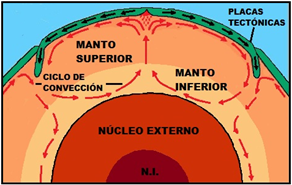Abstract
The existence of different layers inside the Earth was still unknown towards the end of the XIX century. The conformation and delimitation that can be observed today involved an evolutionary process of millions of years that the entire planet had to go through, which is still under study. In this writing, it is described and explained thanks to Seismology as a study area, it was possible to recognize the existence of different types of layers inside the Earth. Likewise, it is concisely explained how from this discovery, the bases were proposed for the establishment of the dynamic processes that until today have allowed to support the formation and evolution of the internal layers and of the planet itself.
References
Barrell, J. (1914). The strength of the Earth's crust. The Journal of Geology, 22(7), 655-683.
Birch, F. (1952). Elasticity and constitution of the Earth's interior. Journal of Geophysical Research, 57(2), 227-286.
Birch, F. (1954). The Earth's mantle. Eos, Transactions American Geophysical Union, 35(1), 79-85.
Bloxham, J., Gubbins, D. (1987). Thermal core–mantle interactions. Nature, 325(6104), 511-513.
Bullard, E. C. (1957). Verhandel. Nederlandsch Geol.-Mijnbouwkund, Genootschup., 18, 23.
Bullen, K. E. (1950). An Earth model based on a compressibility‐pressure hypothesis. Geophysical Journal International, 6, 50-59.
Davies, G. F., Richards, M. A. (1992). Mantle convection. The Journal of Geology, 100(2), 151-206.
Dobson, D. (2016). Earth's core problem. Nature, 534(7605), 45-45.
Grossman, L. (1972). Condensation in the primitive solar nebula. Geochimica et Cosmochimica Acta, 36(5), 597-619.
Holmes, A. (1931). Radioactivity and earth movements: Geol. Soc. Glasgow Trans., v. 18, p. 559-606
Larimer, J. W. (1967). Chemical fractionations in meteorites—I. Condensation of the elements. Geochimica et Cosmochimica Acta, 31(8), 1215-1238.
Rogers, J.J.W., Santosh, M. (2003). Supercontinents in Earth History. Gondwana Research, 781 6(3), pp.357–368.
Shearer, P. M. (2019). Introduction to seismology. Cambridge University Press. 3rd Edition. 442 pp.
Stacey, F. D., Loper, D. E. (1983). The thermal boundary-layer interpretation of "D″ and its role as a plume source. Physics of the Earth and Planetary Interiors, 33(1), 45-55.
Stein, S., Wysession, M. (2009). An introduction to seismology, earthquakes, and earth structure. John Wiley & Sons.
Wegener, A. (1915). Die Entstehung der Kontinente und Ozeane: Vieweg & Sohr., Braunschweig; 2nd ed., 1920; 3rd ed., 1922, translated into English in 1924; 4th ed., 1924, revised by A. Wegener anil translated into English in 1929.

This work is licensed under a Creative Commons Attribution-NonCommercial 4.0 International License.
Copyright (c) 2022 Universidad Nacional Autónoma de México

